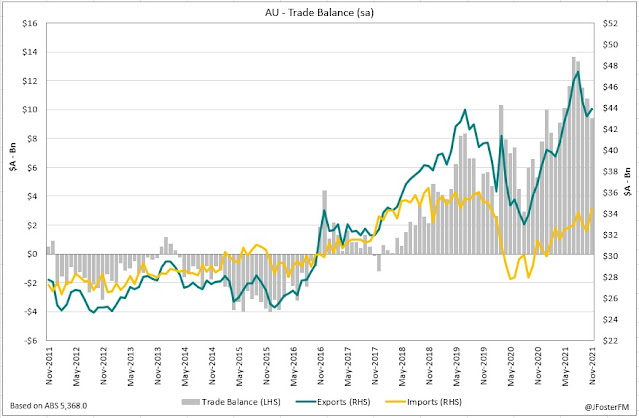Australia's trade surplus has narrowed for a 4th consecutive month but is still at an elevated level of $9.4bn. The recent slide in exports steadied in November while imports have now recovered to pre-pandemic levels.
International Trade — November | By the numbers
- Australia's trade surplus narrowed by $1.4bn in November to $9.4bn vs $10.6bn expected. October's surplus was revised to $10.8bn from $11.2bn.
- Exports were posted at $43.9bn, up 1.6% month-on-month and 19.3% higher over the year.
- Imports lifted at their fastest pace in a year rising by 6.3% to $34.4bn. However, annual growth slowed to 9.4% from 11.4%.
International Trade — November | The details
The surplus on Australia's monthly trade account has come in at in narrowest in 7 months at $9.4bn in November. This was driven by a 6.1% rise in import spending, rebounding from a 4.9% fall over September-October. Exports lifted modestly (1.6%m/m) after falling by 9% over the prior two months. The nation's surplus in goods trade narrowed further but was still vastly higher than pre-pandemic levels. However, the balance on services trade has crept into deficit for the first time since the onset of COVID as overseas travel restrictions started to ease.
Export earnings steadied in November at $43.9bn after plunging iron ore prices drove a 9% fall through September and October. This month, the value of iron ore exports continued to decline but fell only modestly (1.5%). Nonetheless, iron ore exports are down 39.4% from their peak in July at $18.8bn. But helping to attenuate that fall has been coal and other mineral fuels (LNG) with rises of 81.1% and 60.2% respectively since July.
Driving the increase in exports in November was rural goods (13%) as domestic producers continue to see strong offshore demand for cereals, meat and other products. Rural exports have risen by nearly 70% over the year seeing the farm sector contributing significantly to the national recovery from the COVID recession. Services exports lifted 2.3% in the month but are down more than 45% on end 2019 levels, with inbound tourism in November crunched 71.7% over the period due to travel restrictions.
Total import spending was up 6.3% in November reaching $34.4bn to be at its highest level since the end of 2019. The Delta wave hit imports through the prior two months but with lockdowns having run their course, consumption (3.3%) and capital goods (6.7%) were rebounding. Relevant for the former, supply constraints and chip shortages had weighed heavily on new vehicle imports but they had now risen 12% from the depths in September. There was a broad-based range of increases supporting the November rise in capital goods. However, intermediate goods (7.4%) made the largest contribution to the increase in import spending. This was driven by primary industrial supplies (149%) and processed industrial supplies (6.6%). Meanwhile, with restrictions on offshore travel starting to ease in some states, services imports posted a 6.7% rise. Tourism spending was still at a very low level but it had touched its highest since March 2020.
International Trade — November | Insights
Australia's monthly trade surplus continues to narrow but remains elevated and substantially above pre-pandemic levels. Export earnings have come down from peak levels of late as iron ore prices have retraced their highs but still remain strong. Meanwhile, imports have recovered to pre-pandemic levels with domestic demand conditions rebounding from recent lockdowns.






